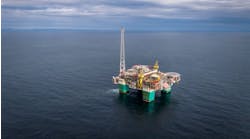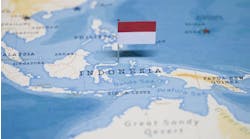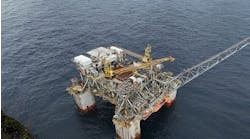Oil and gas development is escalating in the Baltic Sea. Petrobaltic, the region's sole offshore producer is maximizing oil production from the B3 Field via water injection and new subsea wells. Farther north, plans are well advanced for a stand-alone gas development to meet rising energy requirements in northern Poland.
Exploration and production in the Polish sector is conducted exclusively by Petrobaltic. Prior to 1990, this was a state-owned enterprise with shareholders from East Germany and Russia, as well as Poland. An intermittent exploration campaign in the southern Polish Baltic between 1975-90 yielded most of the region's substantial discoveries, headed by the B3 oilfield. However, when the Soviet influence waned in the late 1980s, Petrobaltic was able to re-launch itself as a purely Polish state-owned operation.
The changeover was supervised by Jan Kurek, who remains Chairman to this day. Finance had to be raised to purchase equipment needed to pursue further exploration, as well as to overhaul existing machinery. In 1991, the new company drilled its first exploratory well, B 7-1, but the result was negative.
Offshore production
Priorities then switched to appraisal of the earlier discoveries with a view to generating Poland's first offshore oil production from B3, which lies 70 km north of the Rozewic Cap in 80 meters water depth. Two appraisal wells, B3-4 and B3-6, were drilled and tested, followed by an extended well test from spring 1992. That June, the first 30,000 bbl of crude were delivered to the refinery in Gdansk. Profits from this sale were reinvested into production facilities, including a catenary anchor-leg buoy provided by SBM the following November.
Over the next three years, Petrobaltic drilled its first well with a deviated section on the field, B3-5, and subsequently signed a concession agreement to produce crude and associated gas from B3 in April 1994. Shortly afterwards, it took Smedvig's drilling/production jackup West Beta on charter - this was purchased outright 18 months later and renamed Baltic Beta. Petrobaltic also acquired its multipurpose anchorhandler/installation vessel to lay a pipeline between the jackup and the catentary ancho-leg buoy buoy, from where the stored crude would be offloaded to the 36,000 dwt tanker Icarus II for shipment to Gdansk.
Injection, tiebacks
During the remainder of the decade, Petrobaltic began implementing a series of subsea well tiebacks and later added water injection to boost throughput from this low pressure reservoir. This program is expected to be completed by October 2000. B3 will then have a total of 12 producer and five water injector wells, the majority clustered through four subsea templates. Up to 35,000 b/d of water can then be injected (the current rate is around 25,000 b/d). The result is that B3 will maintain plateau oil production of 10,000 b/d for 5-6 years, followed by a gradual decline until cessation of output in 2012.
B3 has a very low gas-oil ratio - roughly 85 cu meters of gas is produced with each cubic meter of oil. Until now, only 10% of this gas has been used positively, for platform operations; the remainder has had to be flared. However, an accord was recently been signed to pipe this gas direct to a small combined heat and power plant at Wladyslawowo on the Polish coast. Commercial arrangements have yet to be finalized, but Petrobaltic has been proceeding with the project on the basis of first gas deliveries in mid-2002. This has entailed modifications to the Baltic Beta to handle compression, plus installation of two 82 km, 4.5-in. diameter pipelines to Wladyslawowo.
No further exploration is planned around B3, although 30 km away, another oilfield discovery called B8 is under review for a separate development. The last serious exploration campaign in Petrobaltic's 33,000 sq km concession in the southern Baltic was conducted in the late 1990s. Canadian independent Sherritt Oil and came in as partner for this work, but the geological structures identified by the subsequently acquired seismic were too "flat" for the Sherritt's liking, causing it to withdraw for the time being from any further work in the area.
Power prospects
There are four other known gas fields to the north, up to 100 km offshore. Petrobaltic is currently negotiating a production license for these fields, named B-4, B-6, B-16 and B-21. Initial development work would focus on B-6 where Petrobaltic plans to install a 3,000-ton production platform with nine development wells. In time, B-6 would be linked in via three subsea wells, with Cameron providing the trees (as it has done also for B-3). Combined recoverable reserves from these two fields are estimated at 7 bcm.
The plan is to pipe the gas to two power plants in Gdynia and Zarnowiec, with a potential production start in 2003-04. The gas would drive 250 MW turbines over a period of 20 years. Once B4 is depleted, the reservoir could be used for underground storage to cope with fluctuating seasonal demands, although this would be some way off. Petrobaltic's partners in this project are Gaz de France and German utility BEG Berlin.
In the east of the Polish Baltic, D6 is a 10-12 million tonne undeveloped oil discovery on the median line with Russia, lying 20 km offshore in 30 meters water depth. Petrobaltic is discussing a joint development with LukoilKaliningrad and various production schemes are under review, but the project is unlikely to go forward for another two or three years. Petrobaltic estimates shallow water development costs in the Baltic at around $8.50-12.00/bbl.
In its current form, Petrobaltic is a limited company, but remains under partial Polish state supervision. It is looking to boost oil and gas inventory through cooperation with other countries. Joint exploration in the eastern part of the Baltic with Lithuania and Latvia is currently under discussion (initially, probably, with Lithuania). But Petrobaltic may also seek interests in projects farther afield, such as Angola.


